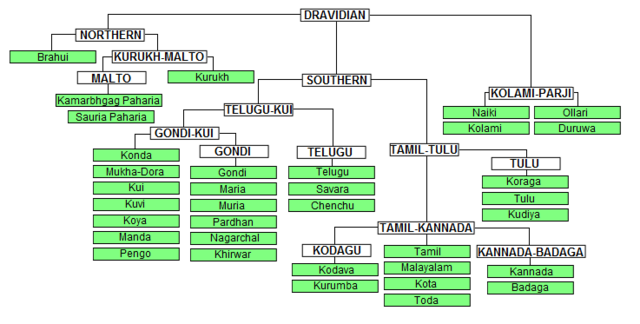Top Qs
Timeline
Chat
Perspective
Kurukh language
Dravidian language of eastern India From Wikipedia, the free encyclopedia
Remove ads
Kurukh (/ˈkʊrʊx/ or /ˈkʊrʊk/;[4] Devanagari: कुँड़ुख़, IPA: [kũɽux]), also Kurux, Oraon or Uranw (Devanagari: उराँव, IPA: [uraːũ̯]),[5] is a North Dravidian language spoken by the Kurukh (Oraon) and Kisan people of East India. It is spoken by about two million people in the Indian states of Jharkhand, Chhattisgarh, Odisha, West Bengal, Assam and Tripura, as well as by 65,000 in northern Bangladesh, 28,600 of a dialect called Uranw in Nepal and about 5,000 in Bhutan. The most closely related language to Kurukh is Malto; together with Brahui, all three languages form the North Dravidian branch of the Dravidian language family. It is marked as being in a "vulnerable" state in UNESCO's list of endangered languages.[6] The Kisan dialect has 206,100 speakers as of 2011.
Remove ads
Classification
Kurukh belongs to the Northern Dravidian group of the Dravidian family languages,[7] and is closely related to Sauria Paharia and Kumarbhag Paharia, which are often together referred to as Malto.[8]

Writing systems
Kurukh Banna script chart for the Kurukh language
Tolong Siki script (bold), next to Devanagari and Latin script
Kurukh is written in Devanagari, a script also used to write Sanskrit, Hindi, Marathi, Nepali and other Indo-Aryan languages.
In 1991, Basudev Ram Khalkho from Odisha released the Kurukh Banna script. In Sundargarh district of Odisha the Kurukh Banna alphabet is taught and promoted by Kurukh Parha. Fonts have been developed and people are using it widely in books, magazines and other material. The alphabet is also used by Oraon people in the states of Chhattisgarh, Bengal, Jharkhand and Assam.[9]
In 1999, Narayan Oraon, a doctor, invented the alphabetic Tolong Siki script specifically for Kurukh. Many books and magazines have been published in Tolong Siki script, and it saw official recognition by the state of Jharkhand in 2007. The Kurukh Literary Society of India has been instrumental in spreading the Tolong Siki script for Kurukh literature.[10][11]
Remove ads
Geographical distribution
Distribution of Kurukh in India, 2011 census
- Jharkhand (47.9%)
- Chhattisgarh (26.0%)
- West Bengal (8.65%)
- Odisha (6.84%)
- Bihar (4.43%)
- Assam (3.69%)
- Other (2.51%)
In India, Kurukh is mostly spoken in Raigarh, Surguja, Jashpur of Chhattisgarh, Gumla, Ranchi, Lohardaga, Latehar, Simdega of Jharkhand; Jharsuguda, Sundargarh and Sambalpur district of Odisha.
It is also spoken in Jalpaiguri district of West Bengal, Assam and Tripura states by Kurukh who are mostly Tea-garden workers.[1]
Speakers
It is spoken by 2,053,000 people from the Oraon and Kisan tribes, with 1,834,000 and 219,000 speakers respectively. The literacy rate is 23% in Oraon and 17% in Kisan. Despite the large number of speakers, the language is considered to be endangered.[12] The governments of Jharkhand and Chhattisgarh have introduced the Kurukh language in schools with majority Kurukhar students. Jharkhand and West Bengal both list Kurukh as an official language of their respective states.[13] Bangladesh also has some speakers.
Remove ads
Phonology
Summarize
Perspective
Vowels
Kurukh has five cardinal vowels. Each vowel has long, short nasalized and long nasalized counterparts.[14]
Consonants
The table below illustrates the articulation of the consonants.[15]
- Medially voiced aspirates and voiced plosives + /h/ contrast, there are some minimal pairs like /dʱandha:/ "astonishment" and /dʱandʱa:/ "exertion". Clusters of voiced aspirates and /h/ are possible too as in /madʒʱhi:/ "middle" and /madʒʱis/ "zamindar's agent".[16]
- Of the nasals, /m, n/ are phonemic; [ɳ] only occurs before retroflex plosives; /ŋ/ mostly occurs before other velars but can occur finally with deletion of previous /g/, there are cases where /ŋg/ and /ng/ contrast; /ɲ/ mostly occurs before post alveolars but /j/ can become /ɲ/ around nasal vowels as in /paɲɲa:/ (or /pãjja:/).[17]
Remove ads
Education
The Kurukh language is taught as a subject in the schools of Jharkhand, Chhattishgarh, Madhya Pradesh, Odisha, West Bengal and Assam.[18]
Sample phrases
Remove ads
Sample text
English
All human beings are born free and equal in dignity and rights. They are endowed with reason and conscience and should act towards one another in a spirit of brotherhood.
Devanagari script
होर्मा आलारिन् हक् गहि बारे नू मल्लिन्ता अजादि अरा आण्टें मन्ना गहि हक़् ख़खर्कि रै। आरिन् लुर् अरा जिया गहि दव् बौसा ख़खकि रै अरा तम्है मझि नू मेल्-प्रें गहि बेव्हार् नन्ना चहि।
Latin script
Hōrmā ālārin hak gahi bāre nū mallintā azādi arā aṅṭēm mannā gahi haq xakharki raī. Ārin lur arā jiyā gahi dav bausā xakhakī raī arā tumhē majhi nū mēl-prēm gahi bēvhār nannā nā cahi.
Remove ads
Alternative names and dialects
Kurukh has a number of alternative names such as Uraon, Kurux, Kunrukh, Kunna, Urang, Morva, and Birhor. Two dialects, Oraon and Kisan, have 73% intelligibility between them. Oraon but not Kisan is currently being standardised. Kisan is currently endangered, with a decline rate of 12.3% from 1991 to 2001.[19]
References
Sources
Further reading
External links
Wikiwand - on
Seamless Wikipedia browsing. On steroids.
Remove ads




